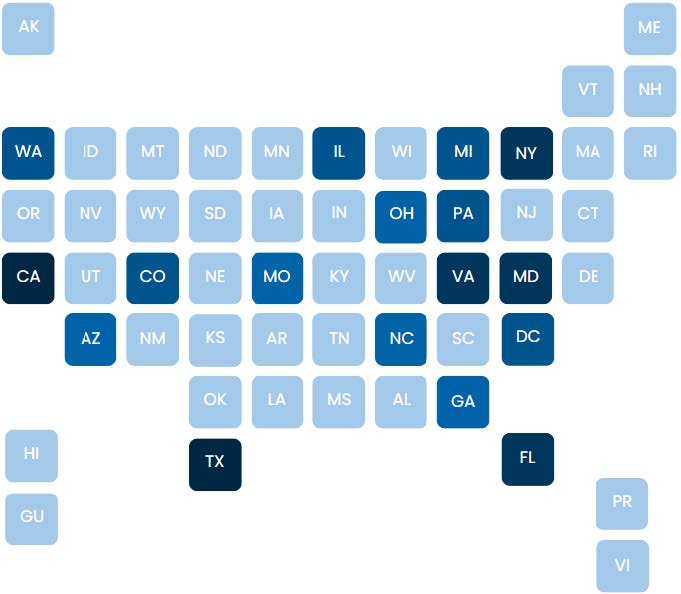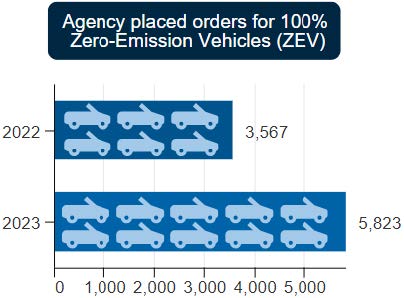Introduction
Our agency serves a vital role in leading our nation’s federal real estate, technology, and acquisition programs. We provide value for communities nationwide and our partners across federal, State, local, and Tribal governments. Our unwavering commitment to great customer experiences provides impact, builds value through decades of innovation, and improves the way customers and partners do business with the federal government. Our story is a good one.
Optimizing federal real estate
With one of the world’s largest real estate portfolios, our agency oversees more than 363 million square feet in 8,300 buildings across approximately 2,000 communities nationwide on behalf of the federal government. As a trusted steward of taxpayer dollars, our Public Buildings Service is helping to optimize the federal footprint and lead the discussion on evolving workspaces. In addition, PBS is delivering on funds appropriated to us through the Infrastructure Investment and Jobs Act ($3.418 billion) and the Inflation Reduction Act ($3.375 billion) to dramatically impact the security of our nation’s borders, and drive the design and construction industry toward the use of new and more sustainable building techniques and materials.
The first of our agency’s strategic goals is real-estate solutions, which includes designing modern, accessible and sustainable workplaces that are financially achievable. Through innovative offerings such as our Workplace Innovation Lab, workplace modeling tools, design services, and more, we have expertise to assess and address fast-evolving federal agency needs. We’ve created federal coworking spaces in several locations throughout the nation for employees to have an enhanced hybrid work experience, promote health and wellness, and support the federal government’s commitment toward a net-zero carbon emissions operation.
We’re also taking a strategic look at our available federally owned space as potential backfill for tenants currently located in commercial leases that are coming up for expiration. We are modernizing many of our Land Ports of Entry, which will help strengthen supply chains, support the labor market, and boost sustainability.
Our Art in Architecture program, now in its 50th year, also engages with communities by displaying more than 500 commissioned artworks in buildings nationwide. These artworks highlight the vibrancy of the nation’s visual arts and create a lasting cultural legacy for the American people.
Efficient and effective acquisition solutions
Throughout our Federal Acquisition Service, we provide exceptional value for our customers in a thriving, innovative, and equitable federal marketplace. In 2023, we helped agencies procure over $102 billion in goods and services. As the acquisition arm of the federal government, we’re able to leverage its purchasing power for our partner agencies, driving down costs and achieving high value through a vast catalog of products and services. As we face complex and important topics like cybersecurity, sustainability, equity, and more, our acquisition expertise helps us meet our clients’ changing needs and support their missions.
Our agency also supports the electrification of the federal fleet. Our federal customers ordered over 5,800 zero-emission vehicles in FY 2023, more than 26 percent of all non-postal service fleet orders. We’re also using a new tool that analyzes an agency’s fleet telematics data, helping federal fleet managers make informed decisions as they transition to zero-emission vehicles.
Digital government services
We remain committed to building a more advanced, resilient, and accountable digital experience by designing accessible, secure, and customer- oriented web products. Our technology offices GSA IT, the Information Technology Category, and the Technology Transformation Services advance digital government through Digital.gov, the U.S. Web Design System, and a wide range of cybersecurity products and services.
Specifically:
- We have implemented the Department of Homeland Security’s Continuous Diagnostic and Mitigation program to protect and secure our environment.
- We advanced our own zero-trust architecture strategy to improve cybersecurity capabilities, enhance visibility across the GSA environment, and proactively manage and respond to threats.
- We’re also leading federal efforts in areas such as technology for our customer agencies and the public. For example, through Login.gov, the public can access benefits and services at participating federal agencies with a single secure online account using email address, password, and multifactor authentication methods. As of August 2023, more than 70 million user accounts had easy and secure access to 43 federal and State agencies.
Enhancing customer experience
The Technology Modernization Fund continues to invest in projects that simplify the public’s interaction with the government to deliver a secure, modern, digital-first experience. This demonstrates meaningful value to the public while reducing the administrative burden for the federal workforce. The TMF is especially focused on “high impact service providers” those agencies that support the most substantial interactions people have with the government as well as people going through a life experience that might require them to interact more with the government.
Through expanded training and robust communities of practice, our Office of Customer Experience has further developed our employees’ capacity so they are better positioned to offer our customers a seamless experience across all touchpoints. Working together with our Office of Human Resources Management, OCE also strengthened the core responsibilities for our agency’s web managers managing public-facing websites to maintain appropriate accountability.
Providing tools for federal government business
In FY 2023, we implemented the Government-wide Procurement Equity Tool and the FAS Supplier Base Dashboard to better connect federal agency partners with vendors who can provide best- value products and services to meet their missions. These are important tools for our small businesses, which make up more than 80 percent of Multiple Awards Schedule contract holders. Our new FAS Catalog Platform simplifies the way vendors manage their product details. Additionally, in FY 2023, we awarded more than $3.3 billion to small businesses, exceeding all small business and socio-economic goals at the prime contract level. For this achievement, for the 13th year in a row, the U.S. Small Business Administration gave our Office of Small and Disadvantaged Business Utilization an A+ rating for FY 2022 on its Small Business Procurement Scorecard. We also partner with the U.S. AbilityOne Commission, an independent federal agency providing employment opportunities to roughly 40,000 blind or disabled people including more than 2,500 veterans through federal procurements.
Building trust through community engagement
Our new podcast, GSA Does That!?, developed and launched by our Office of Strategic Communication, shares stories about the work we’re doing for and with the American public. Agency leaders, experts, and guests discuss key topics such as real estate, technology, acquisitions and more, offering the public, media and other stakeholders a valuable information resource on how we deliver results for our federal partners and the American people we serve. As a federal agency, we are responsible for meeting federal agency space requirements in ways that also advance the social and economic development goals of local communities. With facilities in more than 2,000 communities nationwide from the smallest rural towns to the largest metropolitan areas understanding what local communities need requires robust and ongoing community engagement. GSA incorporates best practices on community engagement into agency business practices and directly engages with local communities, as needed.
Ensuring equal employment opportunity
Aligning our teams for growth and opportunity is foundational to our success. Our people-first culture is based on reinforcing the importance of our Equal Employment Opportunity policy, which is a valuable and transparent means for the public to ensure accountability. GSA’s Office of Civil Rights helps us include civil rights and equal opportunity principles into all aspects of GSA’s strategic mission.
Conclusion
Through our collaborative, people-first, data-driven culture, we’re able to meet today’s challenges and anticipate tomorrow’s opportunities to provide the resilient and modernized government Americans deserve.

 U.S. General Services Administration
U.S. General Services Administration


